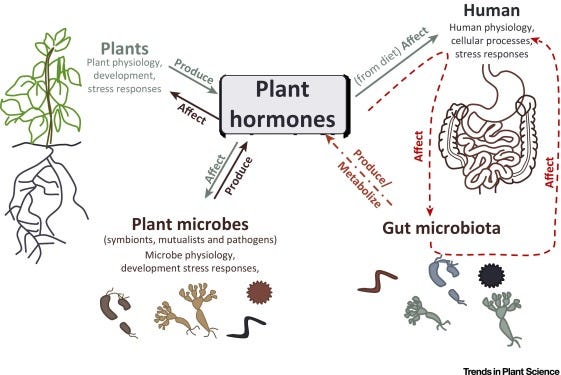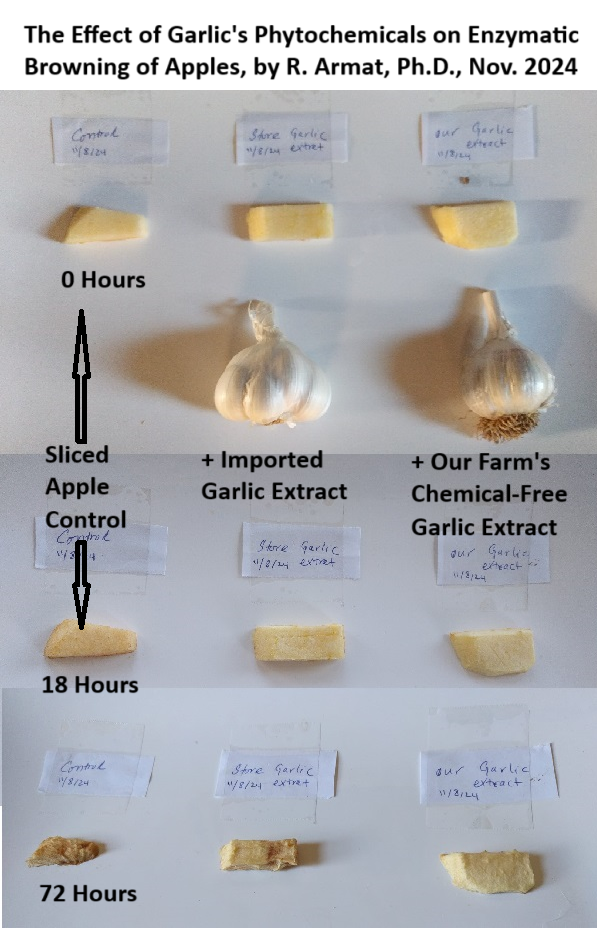Each Vegetable has a Unique Metabolic and Nutritional Fingerprint
Our Experiment Reveals Shocking Differences between Vegetables
Are potatoes selling for $0.50 a pound the same as those selling for $1.50 a pound? Are garlics selling for $20 a pound the same as those selling for $5 a pound? What makes a potato or garlic more nutritious than another? Does it matter if the vegetable is small and dimpled or smooth and large? Can we judge the benefits of a vegetable to our health from its appearance, price, brand or packaging?
These are not easy questions to answer, because our “health” itself is not a well-defined concept, as noted by renowned French-American polymath (microbiologist, pathologist and environmentalist) René Dubos in Mirage of Health: Utopias, Progress, and Biological Change. In fact so-called experts who recommend universal (one-size-fits-all) diets, pills or health-fixing biohacks ignore how “metabolism” works. In The Right Way to Eat, A Handbook About Wholesome Food I, as a chemical engineer and materials scientist, discussed human health in terms of metabolic exchanges and conversions of material (food ingredients converted to biochemicals inside our body such as enzymes, neuropeptides and hormones) and energy, with the goal of staying close to a state of dynamic equilibrium (peace/health) inside and outside our body. In other words, whether a piece of potato is good for our health or not, and its effect on our “vitality” depends on its metabolic exchange with our body and its own state of thermodynamic equilibrium (metabolic health).
Metabolism is the way an organism manages the intra- and extracellular flow and conversion of energy and biochemicals (nutrients) in response to environmental stresses and energy demands. The same way our body’s composition and constitution (muscles, fat, bones, hormones, energy level) is determined by our metabolism, the nutritional composition (macro- and micronutrients) of any vegetable is a function of its metabolic history and stress responses because plants produce phytonutrients (like polyphenols) and hormones (like auxin) in response to free radicals generated by biotic (living) stressors (insects, fungi, viruses, bacteria, nematodes, weeds, etc.) or “abiotic” stresses (exposure to toxic chemicals, pesticides and heavy metals, drought or nutrient deficiency , ozone, salinity, ultra-violet UV radiation or excessive light, high temperature fluctuations).
After farming for a couple years, I have come to the conclusion that each piece of vegetable, like each human, has a unique metabolic fingerprint, energy content and nutritional character, which are functions of the vegetable’s heritage (cultivar, lineage history, seed selection, genes, DNA, etc.) and cultivation (biotic and abiotic stressors). Even vegetables grown in the same farm, like ours, without any chemical input (pesticides or fertilizers), can have different metabolic characters depending on the stressful conditions they experienced during growth in different seasons and in field plots with different soil conditions (moisture, drainage, salinity, pH, mineral content, organic and microbial matter, temperature, radiation, etc.).
To survive and flourish, each plant or vegetable, like all other living organisms, is endowed with its own metabolic machinery to balance energy input (sunlight via photosynthesis, mineralization in soil, etc.) and output (for growth, reproduction and stress management) every step of the way from seed germination and sprouting all the way through growth and flowering and even during harvest, storage and transportation. New research confirms the soil, plant and human microbiota play indispensable roles in the metabolic fitness of their hosts, by mediating nutrient assimilation, stress responses, and hormone production. In other words, preserving symbiotic microbial colonies when growing vegetables preserves the cross-kingdom effects of plant hormones on the metabolic health of humans.
Our Experiments
To preserve symbiotic microbiomes, we use chemical-free regenerative farming practices (you can read my earlier articles on weed management, etc.) so our soil contains no chemical pesticides or fertilizers, as judged by healthy populations of worms, nematodes and putatively, beneficial microbes. Post-harvest, to keep vegetables in a semi-“Living state,” (a term coined by Nobel Laureate Albert Szent-Gyorgyi to distinguish orderly metabolic states from chaotic states in cancer, disease, spoilage, etc.), we store them close to their natural, fresh-harvested state in a cool dark place with stable temperatures between 35-55 degrees Fahrenheit. For root vegetables like garlic and potato, we dust off soil chunks but keep some dry soil on them in storage and only wash them thoroughly later right before enjoying them in foods. You can read more about our observations in Are Dirty/Raw/Ugly Vegetables Better for us? The Wisdom of Keeping Vegetables in a Living State.
Our observations confirm (as seen in the image below) most vegetables grown and stored this way remain relatively crisp and do not wilt or become flaccid for a long time. This can be due to the “structuring” effect of residual water, as discovered by Szent-Gyorgyi, on structural proteins and fibers, as well as the “protection” of stress-management phytochemicals (such as polyphenols) which are preserved by symbiotic microbiota in this semi-“living state.” Thanks to these bioactive phytochemicals, which we also call phytonutrients, our vegetables resist rotting and mold growth for an extended period and then instead of rotting, start shrinking or wilting (losing water structure) and occasionally, like some garlics and potatoes, start sprouting, indicating the start of a new cycle of life and “living state.” We don’t expect to see this “living state” effect in conventional store vegetables which use extensive drying, fumigation, sprout inhibitors, ozonation, antimicrobial techniques to extend shelf-life.
But what does all of this mean in terms of the health benefits to humans? As stated earlier, phytonutrients and plant hormones, which help plants resist fungal or microbial degradation seem to also play a key role in human physiology and stress responses. This is sometimes called xenohormesis, which means molecules such as plant polyphenols, which are indicators of plant’s stress response, can have a similar stress-fighting benefits for other organisms (heterotrophs) like humans that consume it in moderation.
To test the effect of cultivation and preservation processes on concentration of phytonutrients and plant hormones, we sliced and tested our potatoes against a store brand grown and stored conventionally (using pesticides, fertilizers, fumigants, disinfectants, chemical sprout inhibitors, ozone generators, etc.) for enzymatic browning reactions and mold growth, which occur as a result of extensive pathogenic and oxidative damage. As seen after 24 hours, our potatoes easily resisted enzymatic browning and mold growth while the conventionally-preserved potato failed. We also tested different garlic extracts as topical treatments to delay enzymatic reactions and mold growth. In comparison to conventionally-preserved garlic, which offered zero or negative preservation, our garlic prevented enzymatic browning and fungal degradation even in conventional potato.
We also benchmarked the preservation effect of our garlic against conventional (non organic, store imported) garlic on conventional apples, which have higher sugar and water content than potatoes and resist enzymatic browning and degradation for a longer period. As seen in the image, our garlic offered a strong preservation effect even after 72 hours.
Although crude and simple, these experiments on fresh cut potatoes and apples show that our chemical-free cultivation and natural preservation methods prove superior to conventional methods (spraying and post-harvest treatments) with respect to the concentrations of antioxidant phytonutrients like allicin (in garlic), ascorbic acid (Vitamin C) or polyphenols (in potatoes) that function as natural preservatives in vegetables.
Note:
The concept of a “living state” is not new. Life-organizing forces have been described by a variety or names such as life forces, etheric forces (Rudolf Steiner), morphogenic fields (Rupert Sheldrake), or prana (Indian Ayurveda). Besides evaluating the “living state” of any substance by testing its life-preserving qualities, like I did on our farm, there are other methods designed to test and visualize the organizing forces and metabolic/energy state of “living” substances like soils, fruits and vegetables. One such method, promoted by Rudolf Steiner, is the Copper chloride Biocrystallization first invented by Ehrenfried Pfeiffer. In this method, aqueous extract of the sample is added to a copper chloride solution and then inspected under a microscope for unique crystallization patterns that can be correlated with the etheric/living state of the substance. In the 1950s, Ehrenfried Pfeiffer pioneered another method to visually assess the “living” (organic matter) quality of humus in soils or compost. This new method, known today as Pfeiffer's Round Filter Chromatography, employs filter papers treated with silver nitrate. The organic substances, such as soil, compost, vegetables and plants, are mixed with a solution of sodium hydroxide before application to the paper. The unique arrays of forms, colors, and symmetrical patterns are then correlated by Biodynamic farmers to the degree of bioavailability of “living” organisms and biochemicals in the sample.
Sources:
https://www.sciencedirect.com/science/article/abs/pii/S136013851730153X
https://onlinepubs.trb.org/Onlinepubs/sr/sr40/sr40-002.pdf





